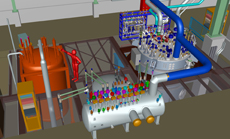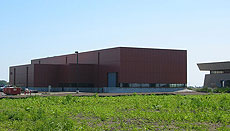Cryogenics at Fermilab: Cooler than a frozen Han Solo
 |
| The model of the Cryomodule Testing Facility shows the SLAC refrigerator in orange. The silver cylinder in the foreground is the cryogenic distribution box, and the large silver cylinder on the right is the superfluid helium cryogenic plant. Image: Dave Richardson, AD
|
Fermilab’s cryogenics R&D may not be able to deep-freeze a brazen Han Solo, but it can cool cutting-edge particle accelerators down—way down—to the optimum operational temperatures.
“No one realizes how important the cryogenic cooling system is until it stops working,” said Jay Theilacker, the head of the Cryogenics Department. “Many of the proposed experiments at Fermilab need to be cooled down to within a couple degrees of absolute zero to operate.”
In 2010, the American Recovery and Reinvestment Act granted Fermilab $114.2 million to cultivate the infrastructure for projects like SRF technology development, NOvA and LBNE. The cryogenics department received $10 million to establish the cooling systems required to chill these projects.
“Fermilab built this entire building with money from the American Recovery and Reinvestment Act,” Theilacker said while giving a tour of the brand-new Cryomodule Testing Facility (CMTF).
“Eventually, R&D for a number of different experiments will move into this building, but before any of these experiments can operate, they will need the cryogenic infrastructure.”

Major construction of Fermilab's Cryomodule Test Facility was completed in January 2012. This facility will house the new cryogenic systems as well as R&D for a number of different experiments. Photo: Jerry Leibfritz
The cryogenics department made two major purchases with ARRA money. The first is a superfluid helium cryogenic plant that employs innovative technology to cool liquid helium to two Kelvin. The second is a distribution box that will send the ultra-cooled helium to experiments that need it. These two purchases are being constructed in Oklahoma and Ohio, respectively.
“These two pieces of equipment are specially designed for us, so we will be monitoring their construction closely,” Theilacker said. “They use cutting-edge technology to get the helium down to ultra-low temperatures and then keep the helium at this temperature while it is cycled to the different experiments.”
Once completed, these two purchases and a refurbished refrigerator from SLAC will occupy a concrete pit at the far end of CMTF.
“When we designed the setup of the cryogenic system, we had to keep two things in mind: functionality and flexibility,” Theilacker said. “Experiments are always evolving, so the cryogenic system must be able to adapt to the changes.”
The cryogenic system must also remain flexible because it will need to accommodate the cooling needs of multiple experiments located in different facilities.
“The SRF projects, for example, are designing multiple cryomodules that use different radio frequencies,” Theilacker said. “We need to be able to distribute superfluid liquid helium to all these cryomodules, which means we need to establish a highly dynamic and efficient system.”
Even though the Cryogenic Department is excited about the two new purchases, it must remain economical and realistic.
“No project ever has enough money, so we reuse and refurbish a lot of equipment,” Theilacker said. “Currently, we are refurbishing about seven compressors and oil filters from the Tevatron. These pieces of equipment will compress and filter the helium that will then be cooled in our new superfluid liquid helium cryogenic plant.”
All cryogenic projects in this building are managed by Arkadiy Klebaner. The cryogenic department plans to have the old equipment refurbished and installed before the new equipment arrives in the spring of 2013.
—Sarah Charley
|